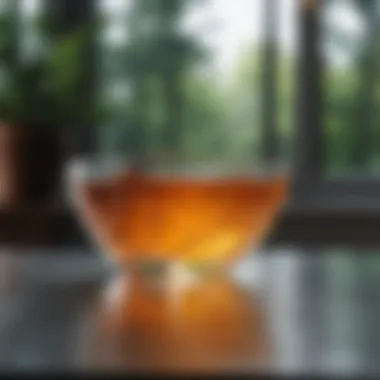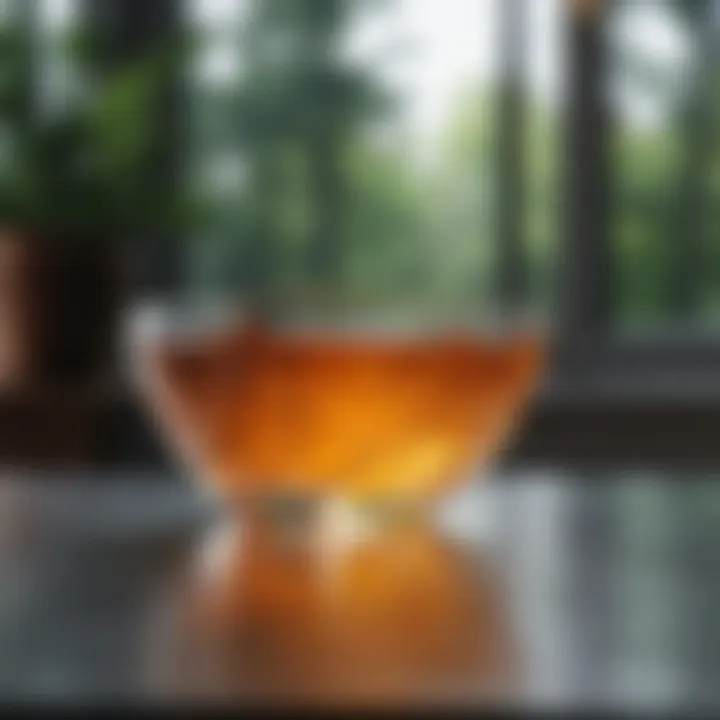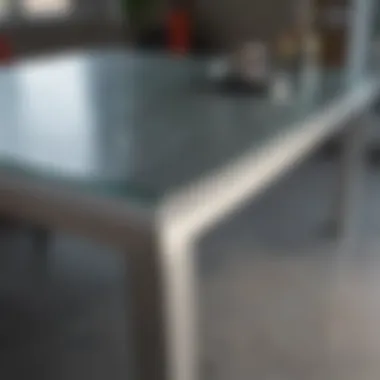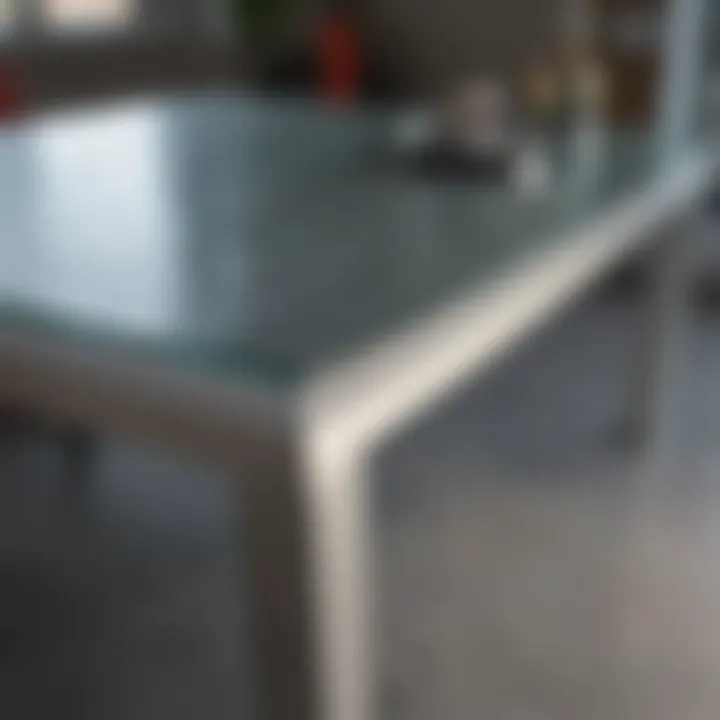Expert Tips for Effortlessly Cleaning Glass Tops


Intro
Cleaning a glass top requires attention to detail and knowledge of appropriate techniques. Glass surfaces are often chosen for their elegance and style, but maintaining their clarity poses challenges. Streaks, scratches, and dust can mar their appearance and longevity. Thus, knowing how to properly clean a glass top is essential.
This guide provides not only practical instructions but also insights into the products and tools available. It covers common mistakes, best practices, and maintenance tips. These strategies will help ensure that your glass tops remain pristine over time.
Through a careful analysis of materials and methods, the following sections aim to equip readers with the skills needed for effective glass cleaning.
Understanding Glass Surfaces
Cleaning a glass top requires awareness of the type of glass being cleaned. Understanding different glass surfaces is crucial. It helps in selecting appropriate cleaning methods and products. Each type of glass has specific characteristics. Knowing these can avoid damage and ensure effective cleaning.
Types of Glass Used in Furniture
Different types of glass are commonly used in furniture design. Knowing their properties can influence cleaning techniques and maintenance strategies.
Tempered Glass
Tempered glass is created by heating the glass and then cooling it rapidly. This process makes it stronger than regular glass. Its strength is a significant benefit in homes with children or pets. The key characteristic is its ability to withstand high impacts. If broken, it shatters into small, blunt pieces, reducing injury risk. However, it is important to be cautious with extreme temperature changes, which may cause cracking.
Laminated Glass
Laminated glass consists of two or more layers of glass with a layer of plastic sandwiched in between. This construction provides excellent resistance to impact. Its key feature is sound insulation, making it ideal for noisy environments. The advantage of laminated glass is its capacity to hold together even when shattered. On the downside, even minor scratches can be more noticeable, which means regular cleaning is essential to keep it looking new.
Low-Iron Glass
Low-iron glass has a lower iron content than standard glass. This makes it clearer and allows for higher transparency. Its brilliance is a considerable advantage, making it popular in high-end designs. The key characteristic is its reduced green tint compared to regular glass, providing a truer color representation. The disadvantage is that it can be more expensive, and its installation requires professional handling to avoid damage.
Characteristics of Glass Tops
Understanding the characteristics of glass tops helps in selecting proper care techniques for cleaning.
Transparency
Transparency is one of the most appealing features of glass tops. It allows for visibility of items beneath the surface, contributing to a clean aesthetic. This unique feature enhances interior design, providing a sense of openness. A main influence on cleaning is that streaks and smudges can be highly visible, making it important to maintain clarity through regular cleaning.
Fragility
Fragility is a decisive aspect of glass tops. Despite their robustness, glass tops can be prone to chips and cracks under severe stress. Glass's fragility necessitates careful cleaning methods to minimize the risk of damage. This means avoiding harsh scrubbing tools that can cause scratches or cracks.
Resistance to Stains
Glass tops generally exhibit high resistance to stains, making them ideal for dining or work surfaces. Their smooth surface makes it easier to remove spills before they become permanent stains. However, this does not mean they are stain-proof. Certain substances, like ink or wine, may still leave stains if not cleaned promptly. Awareness of their resistance capabilities can guide efficient cleaning routines.
Essential Cleaning Supplies
Cleaning a glass top effectively hinges on the right supplies. Choosing appropriate cleaning products and tools is critical in maintaining clarity and preventing damage.
Recommended Cleaning Solutions
Commercial glass cleaners


Commercial glass cleaners are widely available and designed specifically for glass surfaces. Their main advantage lies in their formulation, which often includes ingredients that cut through grime and prevent streaks. A key characteristic is their quick-drying formula, which minimizes the risk of water spots.
However, while commercial cleaners are effective, they can sometimes contain harsh chemicals. This aspect might be a concern for those sensitive to odors or looking for eco-friendly options. Nevertheless, many users appreciate the convenience of these products, making them a popular choice in households. In this guide, we emphasize their efficacy for routine cleaning of glass tops.
Homemade solutions
Creating homemade solutions often appeals for several reasons, including cost-effectiveness and controlling ingredients. Simple mixtures like vinegar and water or baking soda and water can be very effective on glass surfaces. A notable advantage is their environmental friendliness, as they do not contain any harsh chemicals.
On the downside, homemade solutions may not always provide the same immediate results as commercial products. Some stains might require more elbow grease or repeat applications. Nevertheless, for regular maintenance, these solutions can be adequate and safe to use.
Microfiber cloths
Microfiber cloths should be an essential part of any cleaning kit for glass tops. They are designed to capture dust and dirt without scratching the surface. The fibers work effectively to lift debris away rather than spreading it, which contributes to a clearer finish.
One of the compelling features of microfiber cloths is their reusability. They are washable and durable, allowing for multiple uses without degradation in performance. However, they should be washed without fabric softener to maintain their effectiveness. Their low absorbency makes them an excellent choice for glass cleaning, ensuring a streak-free shine.
Tools for Effective Cleaning
The tools utilized in the cleaning process can significantly affect the outcome. Having the right tools ensures efficiency and precision in cleaning glass tops.
Sponge and scrubbers
Sponge and scrubbers are indispensable for removing tougher stains. A good-quality sponge can hold cleaning solutions well, enhancing the cleaning process. The characteristic of a non-abrasive scrubber makes it suitable for glass cleaning, where scratches must be avoided.
However, it is crucial to select a sponge with soft materials. Using abrasive sponges may lead to scratching the glass surface. Therefore, choosing the right type is key to effective cleaning without damaging the glass.
Spray bottles
Using spray bottles allows for controlled application of cleaning solutions. This precision is essential when using both commercial and homemade cleaners. A key benefit of spray bottles is that they can help distribute the solution evenly across the surface.
Another aspect is ease of use for various cleaning tasks. The ability to store homemade solutions in clearly labeled bottles makes it easy to grab what is needed. It’s also a straightforward method to ensure the right amount of product is used every time.
Rubber gloves
Rubber gloves serve multiple purposes during cleaning. Primarily, they protect skin from harsh chemicals found in some cleaning solutions. Additionally, gloves provide a better grip on cleaning tools, preventing slips when handling wet or soapy items.
A beneficial characteristic is their easy-to-clean surface, allowing for repeated use without wear. However, while they provide a layer of protection, some people may find them uncomfortable or sweaty during extended cleaning sessions. Nevertheless, they are a smart choice for anyone serious about protecting their hands while cleaning glass tops.
Step-by-Step Cleaning Techniques
Cleaning a glass top effectively requires a systematic approach. This section outlines the essential techniques to ensure that the glass maintains its clarity and beauty. Understanding these steps contributes significantly to the longevity and appearance of the surface. Specific techniques cater to the nature of glass, reducing the chances of scratches or streaks that can detract from its aesthetics.
Preparation of the Surface
Preparing the surface is the first critical step in the glass cleaning process. Proper preparation sets the groundwork for effective cleaning, making subsequent steps easier and more effective.
Clearing the area
Clearing the area is about removing any objects that may obstruct the cleaning process. This action not only allows for easy access but also prevents potential damage to items or the glass itself. It is essential to keep the surface free of clutter. A clean workspace reduces the risk of smudges when you move items back after cleaning. Moreover, having a clear area enhances your focus on the task at hand.
Assessing the level of dirt
Assessing the level of dirt is crucial as it determines the cleaning approach to use. Different cleaning solutions may be required based on how dirty the glass is. If the surface has heavy dirt buildup, a stronger cleaning solution might be necessary. This assessment ensures efficiency in the cleaning process. Engaging with this step helps in planning the effort and materials needed for optimal results.


Applying Cleaning Solution
The application of cleaning solution is a key component in achieving a streak-free finish. How you apply this solution affects the overall effectiveness of the cleaning.
Optimal application methods
Using the right methods to apply the cleaning solution can significantly impact the results. Common methods include spraying or pouring the solution directly onto the glass. Spraying allows for even coverage and reduces waste. When pouring, it is critical to control the amount used to avoid over-saturation, which can lead to streaks. This attention to detail can greatly improve the clarity of the glass top post-cleaning.
Amount of solution to use
The amount of solution applied is significant in achieving a clean finish. Too little solution could hinder its ability to break down grime, while too much can lead to excessive residue. A moderate amount facilitates effective cleaning without leaving behind streaks. Understanding the balance required in this step plays an important role in maintaining the sheen of the glass.
Wiping Techniques
Wiping techniques are fundamental in removing the cleaning solution and any residual dirt. Proper techniques will enhance the finish and shine of the glass top.
Use of microfiber cloths
Microfiber cloths are specially designed to attract and hold dust and dirt particles. Their soft texture means they are less likely to scratch the glass. This makes them an ideal choice when cleaning glass surfaces. Using a clean microfiber cloth ensures that you do not transfer dirt back onto the glass. Their effectiveness makes them popular among cleaning enthusiasts.
Direction for wiping
The direction in which you wipe can influence the final appearance of the glass. Generally, wiping in straight lines or a specific pattern can minimize the risk of streaking. Following a consistent direction helps to lift and remove grime more effectively. This attention to detail also aids in achieving uniform clarity across the glass surface, highlighting the importance of technique in this process.
Dealing with stubborn stains
Dealing with stubborn stains requires additional care and techniques. These stains may necessitate the use of specialized cleaners or additional scrubbing. Identifying the type of stain can also inform the best approach. For example, grease may require a different method than mineral deposits. A focused strategy for tough stains can enhance your overall cleaning routine and ensure that even the most persistent marks do not detract from the glass's shine.
Tips for Maintaining Glass Tops
Maintaining glass tops is crucial for preserving their appearance and longevity. Regular care can prevent minor damage from becoming major issues. By implementing simple strategies, you can keep your glass surfaces looking new and clear.
Preventive Measures
Coasters and mats
Coasters and mats serve as an essential line of defense against potential scratches and heat damage. These accessories protect the glass from heavy objects and extreme temperatures that can cause warping or cracking. Using coasters with soft surfaces can significantly reduce the risk of scratches that occur from sliding utensils or cups. A key characteristic of coasters is their variety; they come in different materials such as cork, silicone, and felt. This variety allows you to match them with your decor while maximizing their functional benefits.
The unique feature of mats is their ability to cover a larger area, providing broader protection. They are often waterproof, making them a good choice for places prone to spills. However, a downside is that some mats can be heavy, making them less portable than coasters. Nonetheless, their contribution to overall upkeep makes them a vital component in the care regimen.
Regular cleaning schedule
Establishing a regular cleaning schedule is vital for maintaining the clarity of glass tops. It prevents the build-up of dust and smudges that can lead to permanent marks if left unattended. The key to a successful schedule is consistency; having set times for cleaning ensures it does not become a neglected task. A glass top that is cleaned regularly stays fresher and more appealing.
A unique feature of having a regular schedule is the ability to create cleaning habits that become second nature. This helps in detecting potential issues early, such as scratches or stains. However, some people might find the commitment to a strict schedule challenging due to busy lifestyles. To combat this, flexible cleaning intervals can work just as effectively without compromising the care of the glass.
Identifying Damage
Scratches
Scratches are a common issue with glass tops, and recognizing them early can save from further deterioration. They often result from careless handling or using inappropriate cleaning tools. The key characteristic of scratches is their potential to impede the aesthetic quality of glass, as they distort light and create unsightly marks. Addressing these scratches quickly is beneficial because they can worsen over time, leading to more extensive repairs.


The unique feature of scratches is that they can sometimes be difficult to see at first, requiring careful inspection under varying light conditions. However, it is crucial to note that not all scratches are surface-level; some might penetrate deeply into the glass, posing risks to the glass structure.
Chips
Chips are more severe than scratches and can compromise the entire glass top. They occur when a hard object strikes the glass sharply. Their key characteristic is that chips can lead to more significant cracks if not managed promptly. They can cause risks such as glass breaking completely or creating sharp edges. Recognizing chips early on allows for informed decisions about repairs or potential replacement.
A unique feature of chips is that they are often visible without needing special lighting. However, they may require professional attention for repairs. If left unattended, chips can significantly detract from the appearance and usability of glass furniture.
Discoloration
Discoloration is often a sign of neglect, typically arising from prolonged exposure to the sun or harsh cleaning agents. Its key characteristic is that it affects both the visual appeal and the clarity of the glass. Discolored glass might appear dull and lack the shine expected from glass tops. Addressing this issue often requires careful consideration of cleaning products and methods used.
The unique feature of discoloration is that it can sometimes be reversible with the right cleaning techniques. However, consistent exposure may render the condition irreversible. Recognizing the signs of discoloration early is essential; it allows for the introduction of preventive measures to protect the integrity of the glass.
Common Mistakes to Avoid
Cleaning glass tops might seem simple, but making common mistakes can lead to unwanted scratches, streaks, and even damage to the surface. Recognizing these pitfalls is crucial to maintain the clarity and integrity of glass furniture. By avoiding certain products and techniques, you can enhance your cleaning efforts and prolong the life of your glass surfaces.
Using Inappropriate Products
Abrasive cleaners
Abrasive cleaners are often marketed for their ability to tackle tough grime, but they can be highly damaging to glass surfaces. The primary characteristic of these cleaners is their gritty texture, which may effectively remove built-up dirt but can also result in scratches. This creates a significant problem, as even minor scratches can obscure the transparency of the glass.
Harsh chemicals
Harsh chemicals possess strong cleaning properties that can seem attractive for mopping up tough stains on glass. Their characteristic strength often gives a false sense of security regarding their effectiveness on glass surfaces. Nonetheless, this strength can lead to significant issues such as clouding or even etching the glass.
These chemicals frequently contain ammonia or bleach, which can react with the glass itself or the underlying materials, causing additional damage. While they may provide quick results, the disadvantages far outweigh the benefits when it comes to maintaining a glass top. It is wiser to use milder, specially formulated cleaning solutions that preserve the glass and protect it from wear.
Incorrect Wiping Techniques
Using dirty cloths
Using dirty cloths while cleaning glass tops is a common yet avoidable mistake. A dirty cloth can introduce new dirt, grease, or particles back onto your freshly cleaned surface. The key characteristic of a cloth designated for cleaning is its cleanliness and lack of contaminants.
Relying on a used cloth can result in smeared surfaces, which may appear worse than before cleaning. Fresh, clean microfiber cloths trap dirt without scratching, making them an optimal choice. Therefore, ensuring that you use a clean cloth not only prevents adding additional grime but also aids in achieving a streak-free finish.
Wiping in circles
Wiping in circles may seem a natural way to clean any surface, but this technique can actually exacerbate streaking on glass tops. The primary concern with circular wiping is that it can cause uneven distribution of cleaning solution and dirt. When moving in a linear direction rather than circling, you achieve a more consistent coverage that reduces streak formation.
Additionally, this technique allows you to see the buildup of dirt and ensure that each pass is thorough. Thus, using straight lines from one side to another can enhance the cleaning process and yield better results.
In summary, avoiding specific products and techniques is essential for effective glass cleaning. By selecting appropriate products and employing correct wiping methods, the glass surfaces can maintain their brilliance and long-term durability.
The End
Maintaining the integrity of glass tops is crucial for preserving their aesthetic appeal and functionality. Proper care ensures longevity and prevents the accumulation of dirt and stains, which can detract from the overall appearance. This article has provided comprehensive insights into various aspects of cleaning and maintaining glass surfaces.
The Importance of Proper Care
Proper care is not merely about keeping the glass tops clean. It includes a spectrum of practices essential for enhancing the overall life of the furniture. For instance, selecting appropriate cleaning materials and methods plays a significant role in safeguarding against scratches or streaks. Using wrong products can result in lasting damage, which is often irreparable in glass surfaces.
Regular maintenance also helps in identifying potential issues early. Small scratches and chips can be addressed before they worsen and lead to costly repairs or replacements.
Benefits extend beyond appearance. Clean glass tops enhance the ambiance of a space. Their clarity contributes to a modern and elegant look, aligning with contemporary interior designs.
In summary, employing the techniques detailed in this article not only enhances the glass's visual appeal but also maintains its structural integrity over time. It fosters an environment where your glass tops can continue to shine without the burden of unnecessary damage.







